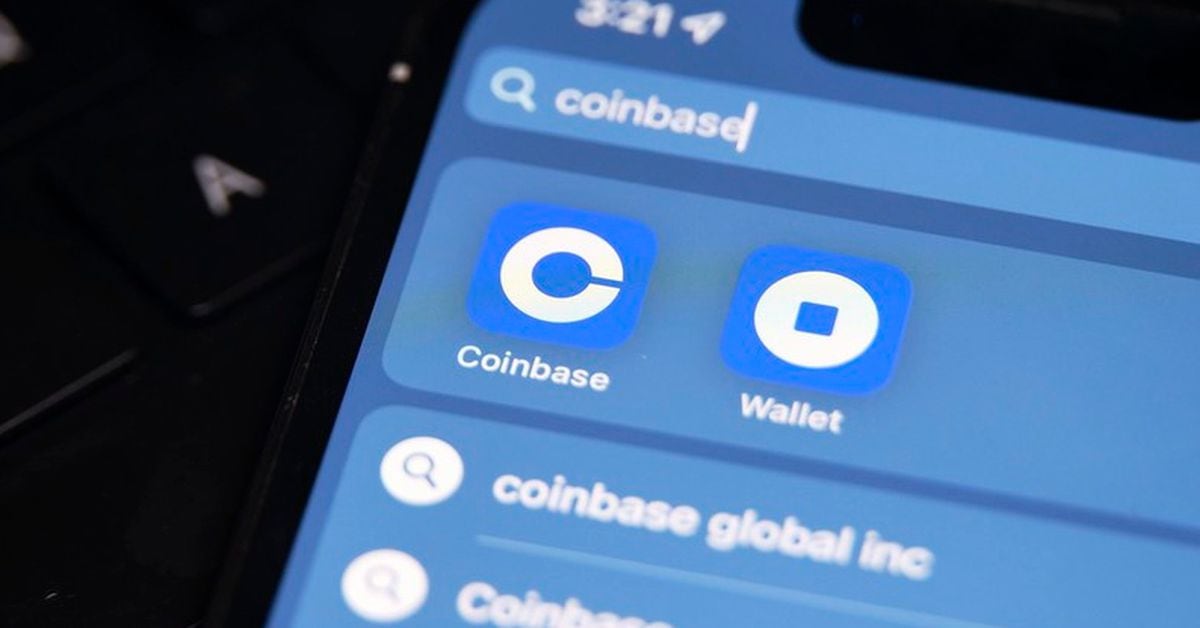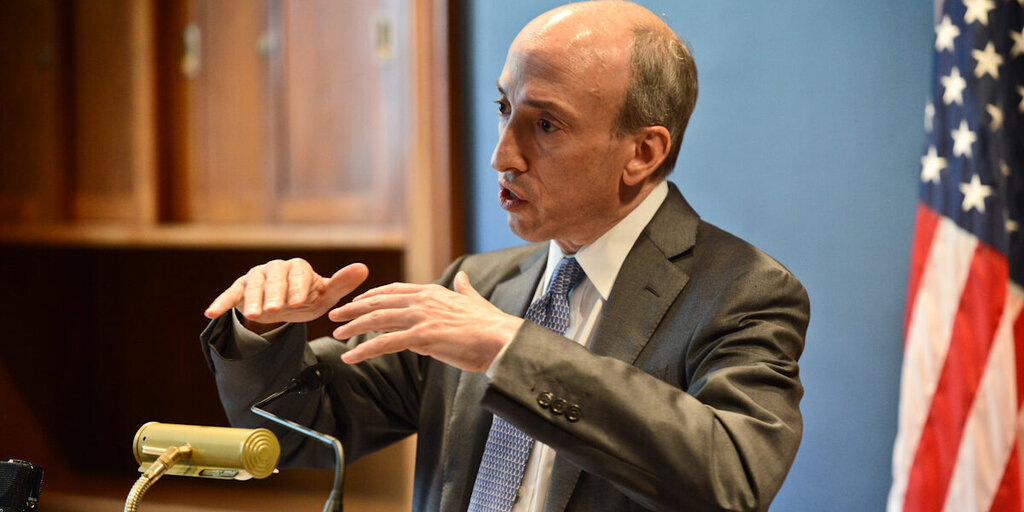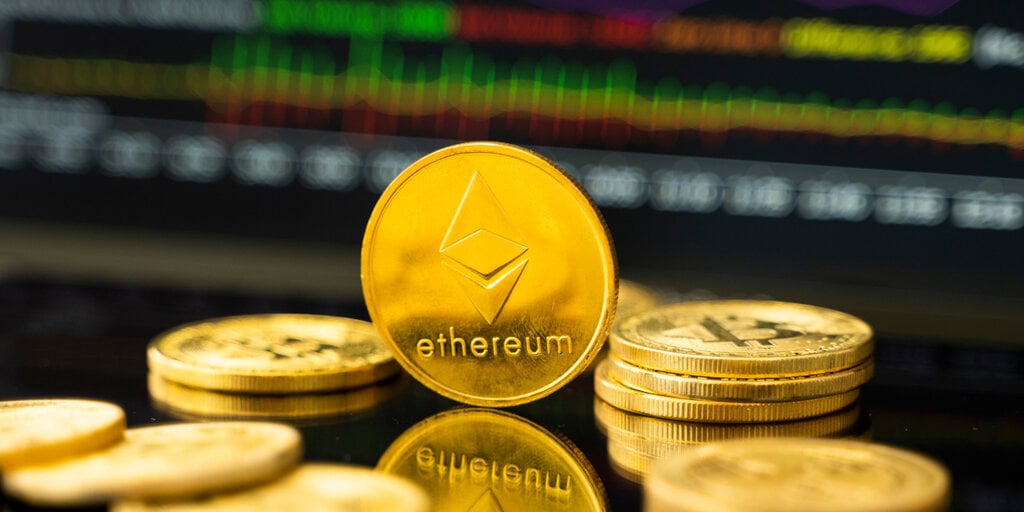Ethereum Foundation Spring 2019 Update
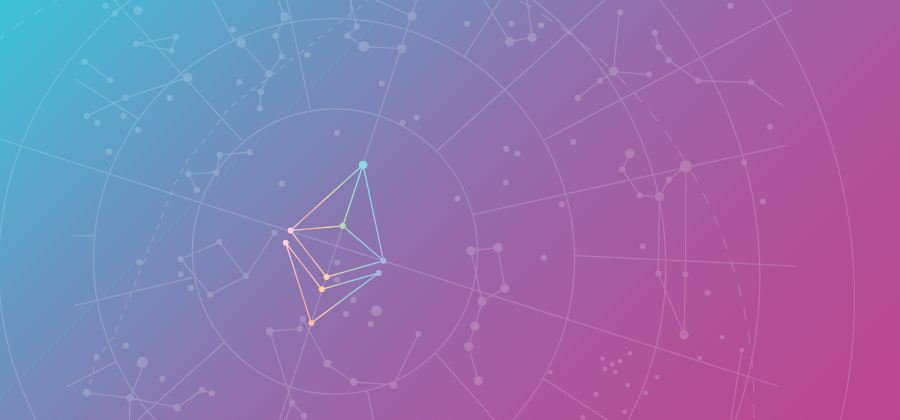
1. Introduction
Ethereum Community,
Ethereum’s future is bright. Over the last 12 months the Ethereum community — a global collection of developers, entrepreneurs, researchers, and passionate users — has made tremendous progress. Every week, new applications built on Ethereum launch to mainnet, scalability solutions come online, and ETH 2.0 moves closer to key milestones. Ethereum remains the de-facto platform for decentralized applications, and is used every day to secure billions of dollars in digital assets.
The Ethereum Foundation’s team is thrilled to see the progress happening across the community. We have worked to support the ecosystem since Ethereum’s earliest days as a non-profit dedicated only to doing what is best for Ethereum.
As the ecosystem has matured, the Ethereum Foundation has refined its focus. “Doing what is best for Ethereum” doesn’t mean trying to do everything — it means focusing on where we can add the most value, and leaving space for others to add value in the areas that they will be the most effective.
So what is the Ethereum Foundation’s role today?
The Ethereum Foundation is a resource allocator, a voice in the ecosystem, and an advocate for Ethereum to the world.
Resource Allocator
Today, the Foundation holds approximately 0.6% of all ETH, as well as reserves held in cash. These resources are intended to decrease over time, as they are invested in critical work across the ecosystem. These are significant amounts of capital but they are not infinite. It is our responsibility to ensure that every last dollar and wei is spent effectively.
We are also working to grow the Ethereum ecosystem’s funding base. This means encouraging other organizations besides the Foundation to support high-priority projects, and supporting innovative mechanisms for funding, including Gitcoin grants and MolochDAO. Efforts like these give us better leverage from our existing resources, and help build a sustainable path for funding vital projects far into the future.
A voice in the ecosystem
We understand that many look to the Foundation as a valued voice even as we move to proactively empower others. That voice is a resource that can be used effectively to advance Ethereum. We are able to, for instance, bring attention to important but relatively unknown projects, share valuable information about Ethereum’s progress with the public, and encourage the growth of regional Ethereum communities.
Moving forward, expect the Ethereum Foundation to be a more active voice in the Ethereum community.
An advocate for Ethereum to the world
To the outside world, Ethereum can be confusing — and that’s probably an understatement. Many newcomers don’t understand our vibrant and decentralized ecosystem because they’ve never seen anything like it before.
When someone (a major company, a government or a regular person) finds their way into our world, the Ethereum Foundation is often their first stop. The first thing we tend explain is that the Ethereum ecosystem is distributed and not owned or operated by any foundation or organization. Our Foundation helps to represent Ethereum to the outside world as an effective portal that people can pass through to the ecosystem itself.
We also recognize a need to take more initiative in growing the Ethereum ecosystem, on-boarding developers and improving the developer experience. As discussed in more detail below, we intend to deploy significant resources towards these goals.
2. Our Philosophy
Ethereum is not a typical open-source project, and the Foundation is not a typical organization. Successfully fostering a vibrant decentralized Ethereum ecosystem requires a specialized approach.
Even as we deploy significant resources across the ecosystem to improve Ethereum, we must do so in a way that maintains the core spirit of decentralization. We have deliberately adopted a philosophy of subtraction, which informs everything that we do.
In plain language, following a philosophy of subtraction means resisting the natural tendency of organizations to grow and accumulate value within themselves, and ensure instead that this value is created outside the Foundation in the broader Ethereum ecosystem.
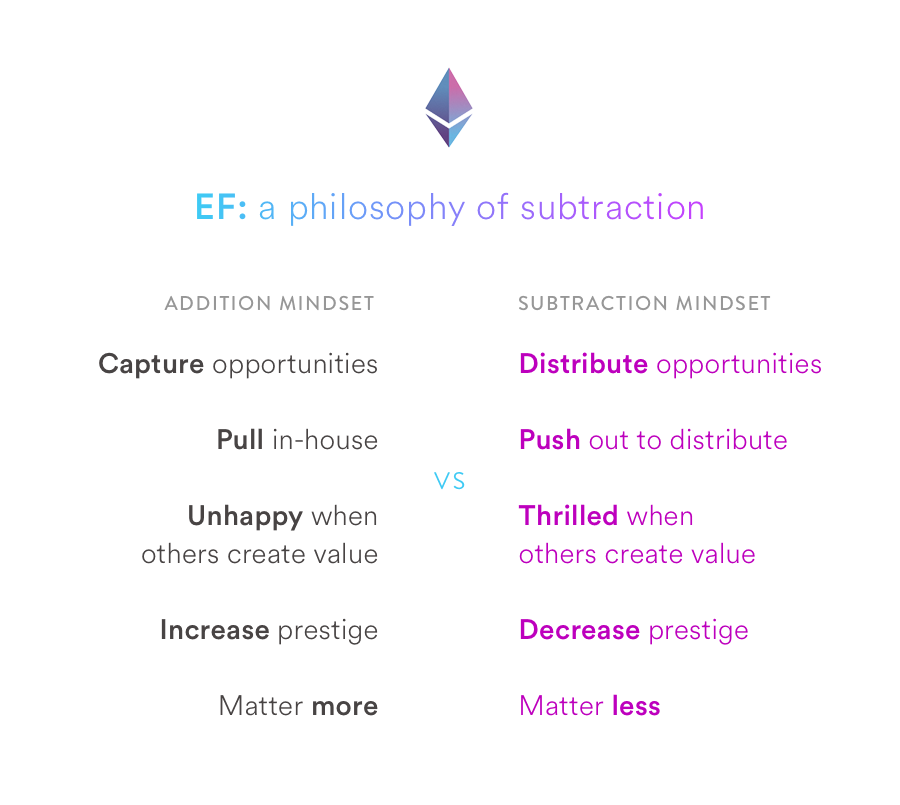
Instead of capturing opportunities for ourselves, we distribute those opportunities to the community. Instead of pulling everything in-house, we push our resources out to teams across the ecosystem. We don’t compete with the ecosystem — we are thrilled when other organizations create value, because that means Ethereum is becoming more decentralized and sustainable.
The Ethereum Foundation succeeds if Ethereum succeeds, and Ethereum succeeds with a strong decentralized community. That understanding governs how we work.
3. Highlights from Ethereum Foundation-supported teams
The last 12 months have been a crucial period for Ethereum, and we have worked extremely hard to support teams across the ecosystem. Encompassing all the progress made by teams supported by the EF in this letter is impossible, but here is a selected sample:
ETH 2.0 client teams
ETH 2.0 is a name given to a set of transformative upgrades for the Ethereum protocol. Last year, this effort moved from a research project to an engineering effort. Client teams supported by the Foundation including Nimbus, Prysm, Sigma Prime, and Substrate Shasper are among those working to turn ETH 2.0 into a reality.
Over the last few months the Nimbus, Prysm, and Sigma Prime’s Lighthouse testnets have launched. These teams and others are now stabilizing and optimizing their clients, getting ready for multi-client testnets.
Many resources are shifting into testing, fuzzing, and audits over the coming months. We engaged Runtime Verification to formally verify the deposit contract and to formally specify the Beacon Chain. This is in addition to considerable effort by the research, development, and security teams involved in ETH 2.0 toward reliability and security.
ETH 1.x
The ETH 1.x initiative, which started last year, focuses on improving Ethereum’s short term scalability and sustainability with an eye to easing the transition to ETH 2.0. Efforts we’ve funded include Alexey Akhunov’s research into stateless clients and state fees, and Andrew Ashikhmin’s research into sync protocol improvements.
Work continues on essential projects like Geth and Solidity as well, and regular updates from all supported teams are on the way.
ZK-rollup
ZK-rollup uses succinct zero-knowledge proofs to enable Ethereum to reach hundreds of transactions per second. We’ve supported Barry Whitehat and Matter Labs’ collaboration, which has led the way on research, development, and implementation.
ETHGlobal
ETHGlobal hosts Ethereum hackathons around the world, focused on on-boarding new developers into the ecosystem and facilitating project and company creation. At a recent event, ETHCapeTown, 70% of attendees were from South Africa and 40% of attendees were new to Ethereum.
Ethereum Academic and Research Collaboration
The Ethereum Foundation hosted three research workshops at Stanford and MIT, through which dozens of talented mathematicians, computer scientists, and economists were introduced to research problems originating in Ethereum. Many have continued working on these problems, leading to progress in areas essential to the future of Ethereum including Casper CBC, VDFs, Plasma constructions, succinct zero knowledge proof based systems, liveness, and safety bounds for Ethereum 2.0 among others.
Additionally, the Cryptophage collaboration between the Ethereum Foundation, Supranational, and Protocol Labs produced a solution to renowned cryptographer Ron Rivest’s LCS35 time capsule crypto-puzzle that required only two months, as opposed to the projected 35 years.
Working with prominent organizations to encourage their engagement with the Ethereum ecosystem
In our role as an advocate for Ethereum to the outside world, the Foundation has worked to encourage high profile organizations to engage with Ethereum in ways that strengthen the whole ecosystem.
Notably, we have been working closely with Microsoft in a long-term commitment to support the Ethereum developer experience through Visual Studio Code and the new Azure Blockchain Service.
We have also connected with large entities like HTC and Opera, encouraging them to engage with the Ethereum community and support Ethereum-based applications, and with non-corporate organizations like UNICEF to help find ways to use Ethereum for social good.
There’s a lot more being done by Foundation-supported teams than just the examples listed above. Stay tuned for more updates coming from these teams in the next few weeks.
4. Allocating Resources over the next 12 months.
An ecosystem-level view for Ethereum support
Today, we’re excited to share more information about the Foundation’s priorities for the next year, and how we expect to allocate resources across the ecosystem.
As we’ve learned and iterated, we’ve made necessary changes to our processes and priorities. When the Ethereum ecosystem was much smaller, it made sense for the Foundation to prioritize several “in-house” teams to work on the most fundamental projects. As the community grew, we began a Grants program that enabled us to support more teams throughout the ecosystem.
Today, it shouldn’t matter to the Foundation whether a project is “internal” or “external”. What matters is that we’re spending resources effectively, and that Ethereum’s goals are accomplished. This is why we are moving toward an “ecosystem level view” when allocating resources by looking at the whole picture rather than at a subset of it.
Over the next year, the Ethereum Foundation plans to spend $30 million USD on key projects across the ecosystem. This budget is insulated against downward ETH price movement.
We believe that this is a critical time for Ethereum, justifying significant investments in important work across the ecosystem.
Allocating across such a large and vibrant ecosystem is a substantial optimization challenge. We are constantly re-evaluating and optimizing our decisions, and new opportunities for leverage appear every day.
To help clarify how we define our highest priorities, we describe below three primary categories of resource allocation: (i) Building the Ethereum of tomorrow, (ii) Supporting the Ethereum of today, and (iii) Developer Growth & Awareness.
i. Building the Ethereum of tomorrow
$19 million earmarked over next 12 months
Ethereum remains a highly ambitious technical project, and significant resources are required to fund the R&D that will realize the Ethereum community’s ambitions. Critical work is underway across the ecosystem on active engineering projects like ETH 2.0, and on more long-term investments like growing the academic community’s involvement in Ethereum technology.
This includes:
- ETH 2.0: Client teams, Research, VDF, documentation and communication
- Layer 2: State channels & Plasma
- Continuing work on eWASM
- Smart contract languages
- Formal verification, auditing, and specification work
- Zero-knowledge R&D, including ZoKrates
- Ethereum “Phase 3 and Beyond” R&D
- Working directly with academic institutions and attracting exceptional research talent
ii. Supporting the Ethereum of today
$8 million earmarked over next 12 months.
Ethereum is used in production today to secure billions of dollars of assets and as a base layer for many hundreds of live applications. We believe that it is vital to continue supporting these efforts to ensure that “Ethereum 1.0” continues to be the world’s dominant smart-contract platform.
This includes:
- Many initiatives under the banner of “ETH 1.x”
- Geth
- Solidity
- Web3.js and Ethers.js
iii. Developer Growth & Awareness
$3 million earmarked over next 12 months
Developers, developers, developers.
Ethereum is a platform and the developers who build on it are a key part of our future. It is critical to invest in developer relations, education, and on-boarding today in order to grow the Ethereum community and to ensure our continued success. This is especially important in Asia, where significant opportunity exists for Ethereum to grow.
This figure also includes more traditional efforts to grow awareness of Ethereum, through marketing efforts at both technical audiences and at users of Ethereum-based applications.
This includes:
- Developer education & on-boarding
- Supporting community event organizations focused on developers, like ETHGlobal
- Continuing to run Devcon as a yearly gathering for the Ethereum ecosystem
- Supporting regional Ethereum community organizations
- Developer experience improvements and developer tooling
- Attracting exceptional developer talent
- Encouraging browsers and other mass consumer technologies to seamlessly integrate Ethereum into their user experiences
- Continued improvements to ethereum.org
5. Thank you!
Ethereum’s progress over the last 12 months is worth celebrating, and as we look ahead we’re more excited than ever before.
Everything we describe above, every technical improvement, event and initiative was accomplished by one of you. This may be a letter from the Ethereum Foundation, but it’s a letter about the Ethereum community. Whether you are new to all of this or you’ve been around since Genesis, thank you for all of your support and contributions. We are excited to keep building the Ethereum ecosystem together.
